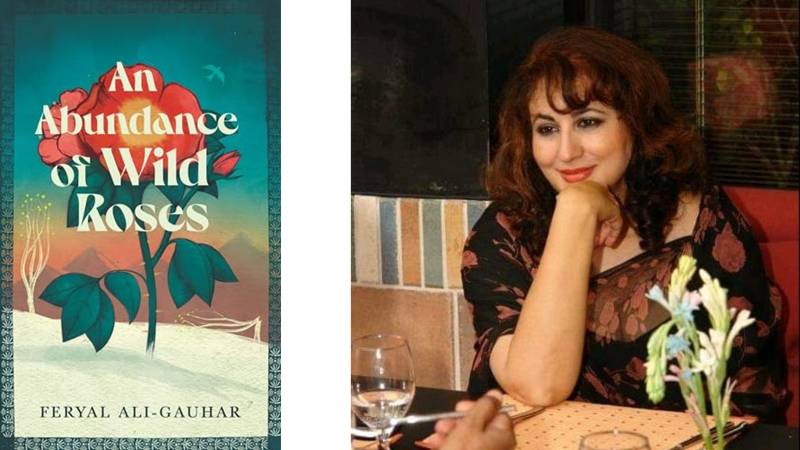
An Abundance of Wild Roses is Feryal Ali-Gauhar’s latest foray into the literary world. She is a prominent actor, journalist, filmmaker, development worker and writer. The novel begins as two young cousins Hassan and Noor discover a wounded stranger underneath a gigantic tree while they are out searching for wood. Saudukh Das is their small village set in the Black Mountains of Pakistan, in a remote area of Skardu. The discovery of this stranger seems to be an ominous sign in the novel, right from the start. The stranger is dragged to the Numberdar’s (head of the village) house by Hassan and Noor using a rope borrowed from the lame boy Lasnik. Feryal lays great emphasis on how this rope has been gifted to Lasnik by a kind Englishwoman who was trying to make life better in the north. Lasnik is constantly predicting doom for the village right from the onset of the story, but it is all falling on deaf ears.
The Numberdar of the village is a proud man named Moosa, who is faced with numerous issues – this strange, injured man being just the tip of the iceberg. Moosa has three wives – Khadijah, Fatimah and Mariam. He also has a beautiful golden-eyed daughter, Sahiba, who has received a love letter leading to her father’s fury. She is locked up in the storeroom as a result, and not even allowed out to use the washroom. Zarina is the local lady health worker (LHW), raising her children and trying to educate them, while her husband is away. It is Zarina who is called upon when the stranger is at Moosa’s house, to clean his wounds and help out the three men. What these old-fashioned men don’t realize is that it is Zarina’s knowledge of modern medicine which is helping them out at every stage of their turmoil. She saves the strangers life before he can be taken to a hospital, miles away.
In my view, the title of the novel is an allegory to the abundance of beautiful women and daughters in this remote village, all trying to make do with their fate - and not just making do, but like wild roses, blossoming and blooming
Another storyline is that of the wolf-dog Malika, who fights ice and conquers death to loyally save a soldier, Ibrahim’s, life. Amongst the characters, Kulsoom’s story is perhaps the saddest as she is constantly beaten by her addicted-to-cough-syrup, useless husband, Naushad, for bearing him only four daughters. Adding to Kulsoom’s distress is the fact that she is pregnant again. Spoilt Naushad who lets his old father and sisters do all the manual work – supported by his doting mother – is constantly bemoaning the lack of a son and Kulsoom is fearful that if she produces a fifth daughter, her life will be worse than living hell on Earth. If only to find out what happens to Kulsoom, I would advise the reader to give the novel a read.
As the story ripens, the characters deal with problems of life and death, and a very old-fashioned way of life is at war with the modernity of today’s world. Feryal even introduces us to a Shia dirge or two, written beautifully, and all the names of her characters seem to be heavily influenced by Muslim history. Central to the story is showing the stark contrast that a person’s thinking can make. Zarina’s husband is open-minded and so her life is much simpler and ‘modern’ where as Kulsoom’s only wants sons and believes that women are only capable of being housewives, taking care of their husbands and bearing preferably male children. The book shows us the negative side of misplaced ‘honour’ as well, as witnessed by what happens between Sahiba’s admirer and Moosa. Sahiba’s admirer is a westernized laboratory assistant who unsuccessfully tries to teach Moosa that there is nothing wrong with his respectful feelings for Sahiba and that he wishes to marry her. Moosa is shown to be too narrow-minded: to witness the ending the novel is a must read.
In my view, the title of the novel, An Abundance of Wild Roses, is an allegory to the abundance of beautiful women and daughters in this remote village, all trying to make do with their fate - and not just making do, but like wild roses, blossoming and blooming. I admired how Feryal began all the chapters in the novel with a story from folklore – it was moving and informative. The book was full of suspense and Feryal’s prose kept me wanting to turn the page and I finished it quickly. It is a must-read for anyone interested in the destiny of young girls in remote areas of Pakistan.
Feryal writes with complete passion and dedication about her central themes – feminism, environmentalism, and the elements that must be respected about dissimilar cultures. However, her language is flowery and this gets in the way of appreciating her absolute talent as a writer. The language, had it been watered down to use simpler words at places, might have made the novel even more appealing, especially to outside readers from different cultures trying to understand complex situations such as a man having several wives, and the harsh natural calamities that face those living in the north of Pakistan. That said, the story is exceptionally well-told and beautifully executed, and is nonetheless exemplary in exploring oft-ignored themes in Pakistani literature with such grace and elegance that could only have been tasked to a talented person of Feryal’s calibre.
Reading the book made me proud of Feryal and proud that a Pakistani author had produced, with such dedication, not merely a work of art but a masterpiece. I would recommend it as a must read for everyone, from all walks of life. Keep a thesaurus at hand, though!

